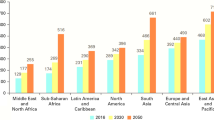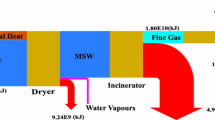Abstract
Although waste-to-energy (WtE) may reduce the amount of waste disposed and recover the heat in the form of electricity or steam, it has limitations in terms of stable energy resources due to uneven waste properties and variation in waste generation and heat requirements by season. The purpose of this study was to analyze the energy production and actual utilization in resource recovery facilities and to secure the preliminary data for its efficient utilization. Four WtE plants were investigated in Seoul metropolitan area. This study analyzed the heat recovery efficiency of each WtE plant using different estimation formula. As a result, that of facility A was 0.74 by Korea’s energy efficiency method, which was the highest among the WtE plants. In facility D, energy loss was the highest due to a mismatch of pollution control facilities. It means energy recovery efficiency could be improved through optimization of treatment processes and final energy utilization. In summer, energy is being wasted by steam throwaway, because heat demand is relatively low compared to other seasons. Thus, the alternative application like district cooling needs to be considered to improve energy efficiency as well as other private businesses or district heating using additional steam.



Similar content being viewed by others
References
Grosso M (2010) Efficiency of energy recovery from waste incineration, in the light of the new Waste Framework Directive. Waste Manage 30:1238–1243
Rosen MA et al (2008) Role of exergy in increasing efficiency and sustainability and reducing environmental impact. Energy Policy 36:128–137
Park S-W (2014) Energy recovery of municipal solid waste: high-efficiency incineration technology. J Kor Soc Waste Manag 31(2):125–133
Kim K-H (2016) Incineration heat energy recovery calculation method of domestic incineration facilities. J Kor Soc Waste Manag 33(4):357–365
World Energy Resources (2013) Waste to energy. World Energy Council, p 7b.2
Ministry of Environment of Korea (2009) Current status of waste generation and treatment (in Korean)
Ryu CK, Shin DH (2013) Combined heat and power from municipal solid waste: current status and issues in South Korea. Energies 46–49
Seo Y (2013) Current MSW management and waste-to-energy status in the Republic of Korea. Columbia University, pp 49–58
Ministry of Environment of Korea (2009) Notification 2009-66 of the Ministry of Environment
Guidelines on the interpretation of the R1 energy efficiency formula for incineration facilities dedicated to the processing of Directives Annex II, 19 November (2008) Municipal solid waste according to Annex II of Directive 2008/98/EC on Waste by the European Commission, June 2011
The energy efficiency formula of Annex II of the waste framework directive (2006) A critical review
Ministry of Environment of Korea. Waste Management Act regulation Article 2-214. Materials and energy from municipal waste, Chap. 5, p 100
Energy Report CEWEP. III (Status 2007–2010) Result of specific data for energy, R1 plant efficiency factor and NCV of 314 European Waste-to-Energy plants
Acknowledgements
This project was supported by the 2015 Research Fund of the University of Seoul.
Author information
Authors and Affiliations
Corresponding author
Rights and permissions
About this article
Cite this article
Yeo, S.G., Nhai, N.T.H. & Dong, JI. Analysis of waste-to-energy conversion efficiencies based on different estimation methods in Seoul area. J Mater Cycles Waste Manag 20, 1615–1624 (2018). https://doi.org/10.1007/s10163-018-0725-6
Received:
Accepted:
Published:
Issue Date:
DOI: https://doi.org/10.1007/s10163-018-0725-6




